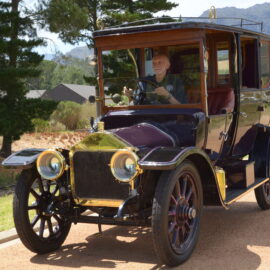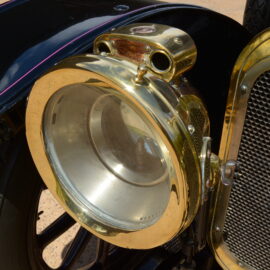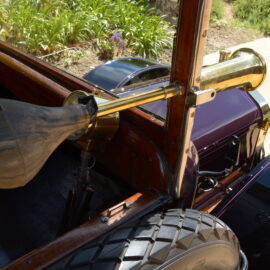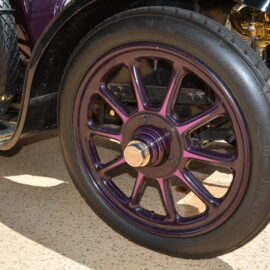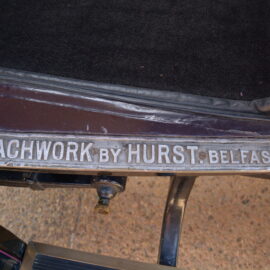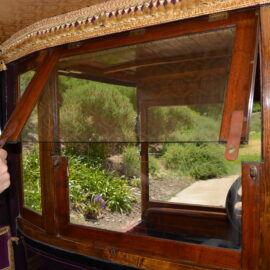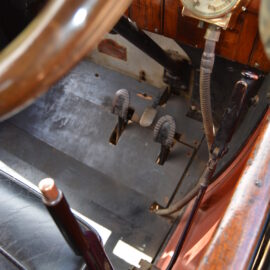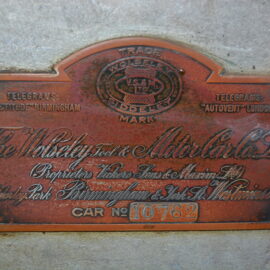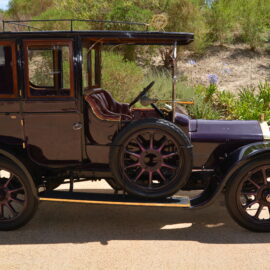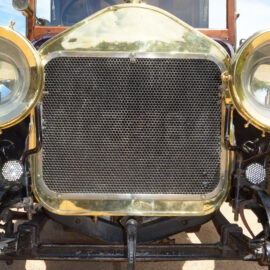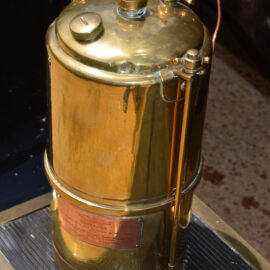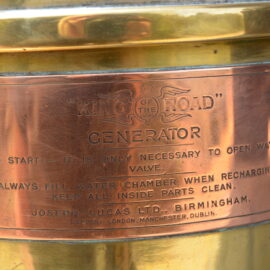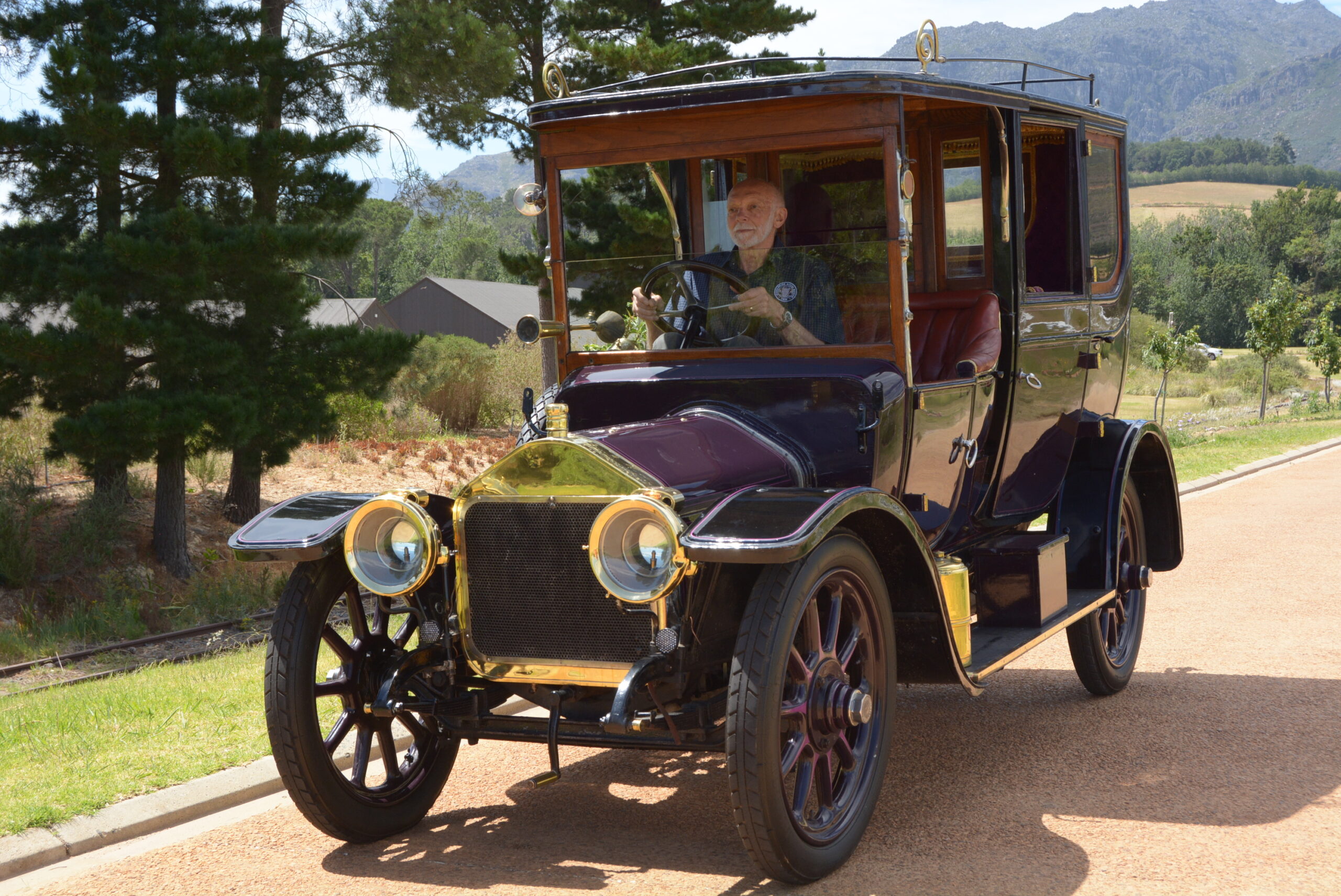
25 Feb Collection In Action: Wolseley 12-16
By virtue as being listed in the Wolseley Register, FMM was recently advised of a new block-casting initiative being undertaken for the Wolseley 12-16 that was manufactured from 1910 to 1912. Fortunately, the museum’s car’s 1910 Town Car is still in good order and the car’s history is a fascinating one, as Mike Monk explains…
The history of Wolseley goes back to 1887 when Dublin-born Frederick York Wolseley established the Wolseley Sheep-Shearing Machine Company to make the most of the many patents he had devised for sheep-shearing equipment while working in Australia. More than 90 patents were registered but the company was struggling due to supply and manufacturing difficulties and Wolseley himself was suffering with ill health. Herbert Austin was working Down Under at the time and took interest in the company, pointing out to Wolseley where his design and construction methods were going wrong. Wolseley was impressed and Austin was appointed manager in 1893. Wolseley later resigned then passed away in 1899.
By this time the company had been set-up in Birmingham, England and was operating successfully, even to branching out to make bicycles. Then Austin’s entrepreneurial spirit led him to travel to Paris to look at the pioneering horseless carriages that were all the rage. Inspired by what he saw, he returned home to England and produced his own three-wheeler that was a copy of a Léon Bollée but with some Austin-designed improvements. Rather than the French car’s single, it had a twin-cylinder engine driving the rear wheel. However, due to patent rights, the car was never produced.
Undaunted, Austin made a second car, also a three-wheeler but with the single wheel at the front. Austin drove the prototype from Birmingham to Rhyl, in Wales, and back (400 km) at an average speed of 13 km/h but, again, no more were made despite a sales brochure (one of the industry’s first?) being made for the car.
Third time lucky. Austin made a four-wheeler with a single-cylinder 3,3 hp (2,5 kW) horizontal engine and took part in a 60 km timed run from Birmingham to Coventry and back in conjunction with the Midland Cycle and Motor Car Exhibition in January 1900. The Wolseley Voiturette, which cost £270, finished second on the event and won a silver trophy for its climb of the 1,6 km Mucknow Hill. This success was the precursor to the 11-day Thousand Miles Trial around Britain. Austin won his class and received a silver medal from the Automobile Club of France and £10 prize money from the Daily Mail newspaper.
Enter Hiram Maxim. Maxim was the inventor of the machine gun that bears his name, and a member of the Vickers, Sons & Maxim Company. Maxim had consulted Austin a number of times regarding the design of flying machines that he was developing and constructing, and made use of a number of suggestions made by Austin. Wary of becoming too involved in the motor car business, this friendship led to the sheep-shearing side pulling away to allow the Wolseley Tool and Motor Car Company to be incorporated in March 1901. With capital of £40 000 invested by Vickers, Sons & Maxim, the new company set about manufacturing motor cars and machine tools, with 33-year-old Austin as managing director.
By May 1901 the company issued its first catalogue of Wolseley cars. There were two models, a 5 hp (3,7 kW) single-cylinder with the same engine as the first model, and a 10 hp (7,5 kW) twin, both of which were available with either phaeton or tonneau bodies at prices from £270 to £360. They also listed a racing car and two delivery vans. At this time there was a diversion of opinion over engine layouts, a minority advocating a horizontal layout while a vertical design was the more popular approach. Austin was a ‘horizontal man’, which put Wolseley at odds with its rivals and the company made a loss in its first 10 months. However, profits were made in 1902 and 1903 and prizes were won in sporting events (with Charles Jarrott and C S Rolls amongst the drivers) and at motor shows, but these were followed by five years of losses, brought about mainly by component supply issues.
Austin agreed to build the vertically-engined Siddeley, named after its originator John Davenport Siddeley. The car outsold the Wolseley and so Austin bought out the company and J D became sales manager. But in 1905 the racing programme was curtailed, coincident with a frustrated Austin resigning, leaving J D as general manager. At the Olympia Motor Show, newly-badged Wolseley-Siddeley cars with both vertical and horizontal engines were displayed. Wolseley’s fate was seen to be turning, as was Austin’s – once his contractual obligations to the Wolseley Tool and Motor Car Company ended, he established The Austin Motor Company Limited.
But there is another twist to the tale. Banker Lionel Nathan de Rothschild joined the company bringing his money, but the board was unhappy because people were calling the cars simply Siddeleys and profits were marginal. In 1909 the dissatisfaction led to both Siddeley and De Rothschild leaving the company. Next?
Ernest Hopwood moved from the British Electric Traction Co to become managing director and he was joined by A J McCormack in 1911 as a period of stability began instigated by board member Walter Chetwynd. The company, which had began making commercial vehicles and taxi cabs, regrouped into fewer premises, and the Siddeley name was dropped. A low-priced Stellite model was introduced that was produced by a Vickers subsidiary. Wolseley began making a profit and by 1913 it was Britain’s largest car manufacturer, selling 3 000 cars. During this time Wolseley had introduced the 12-16, which proved to be a very popular model.
The car in the FMM collection is a 1910 Town Car with an ornate body by coachbuilders Hurst of Belfast. Documents relating to Wolseley’s early history are scarce but records held by the British Motor Museum show that this car was originally ordered on 1 November 1910 by Charlesworth Bodies Ltd of Coventry and that the chassis – number 10762 – had nickel fittings. On 17 January 1911 it was dispatched to Booth Brothers in Dublin, and it is reasonable to assume that the car was bodied by this time. (Charlesworth went out of business around 1950 and their records were destroyed.) So, the Hurst body was most likely fitted at a later date, as Charles Hurst only founded this company on 15 June 1911.
Although the roof extends to the top of the windscreen – it carries an ornate roof rack – the rear passenger compartment is separated by a split glass screen, the top half hinged so that conversation with the driver can be made. Upholstery is in rich cerise-coloured studded velvet, the hue matching the pin-striping on the purple painted bodywork. The windows drop down into the doors, old railway carriage-style, by means of a brocade-edged sash. An elegantly-patterned headlining edged with tassels adds to the classy ambience. Access to the front is from the passenger side only, and the sculpted dual seat is trimmed in leather.
The 12-16 is powered by a 2 226 cm3 four-cylinder side-valve engine with a single Zenith carburettor. The 12 refers to the RAC horsepower rating: the engine produced 15 hp (11 kW) at 1 800 r/min. Once the priming cocks have been utilised, the motor swings into life first turn of the crankhandle, and pulls away with enthusiasm thanks to a low first gear. Top – third – gear is high, leaving flexible second to bear the brunt of drive to the back axle. As regular readers will know, my long-legged frame is not commensurate with veteran and vintage ergonomics – the pedals are mounted very close together forcing me to drive shoe-less in order to operate the central accelerator, while the top of gear lever sits in the crook of my right knee. Ah, the joys of pioneering motoring…
The 12-16 was certainly no slouch. A speeding fine was issued on the car for travelling at 143 km/h in a 120 km/h zone in Alberton, only for it to be found that someone was using the Wolseley’s number plates…
The thick-rimmed steering wheel is not overly large and steering effort not too heavy once on the move. Tyres are 815x105s mounted on wooden artillery wheels. The chassis has a wheelbase of 2 819 mm and weighs 762 kg. Suspension is by leaf springs all round and the foot brake operates on the drive shaft while the handbrake works on the rear wheels. The Lucas King of the Road headlamps were powered by a running board-mounted ‘generator’, a cylinder containing calcium carbide that when topped up with water produces acetylene, which ran through pipes to the headlamps where it could be ignited to produce light.
Driving such machinery makes one wonder what thrills the early motorists must have had driving around in such self-propelled elegance. It could not have been easy, but even by 1910 a level of sophistication was already apparent as the motorised age was fast gathering momentum. Wolseley certainly set a high standard, and little wonder the 12-16 was a success.
The company was renamed Wolseley Motors Limited in 1914 and set up an operation in Canada. Post-war, Wolseley began a joint venture in Japan with Ishikawajima Ship Building and Engineering, and the first Japanese-built Wolseley car rolled off the line in 1922. This coalition was the foundation of Isuzu Motors in 1949. The company grew and prospered and in 1921 it manufactured 12 000 cars, continuing to be Britain’s biggest motor manufacturer.
However, over-expansion led to the company going into receivership in 1927 when it was purchased from Vickers by William Morris (later Lord Nuffield), who pre-war had bought a Wolseley taxi while running his garage, hire car and bicycle manufacturing businesses. Up to this point, at various times Wolseley had built motor cars, aircraft and aero-engines, gliders, railcars, a gyro car, boats, armoured cars, buses and ambulances, not to mention mines and depth-charges. Wolseley was incorporated into the Morris Motors empire where it became a badge-engineered product under BMC, BMH and British Leyland ownership before the name was dropped altogether in 1975, an unflattering finale to what was once a dominant force.
Visitor Note: The 1910 Wolseley 12-16 Town Car is currently on view in Hall A.
(This story is based on my article that first appeared in the Jan/Feb 2017 issue of Classic Car Africa magazine – MM. For further information on the 12-16 block casting programme, contact John Winer at jbwiner@gmail.com.)




